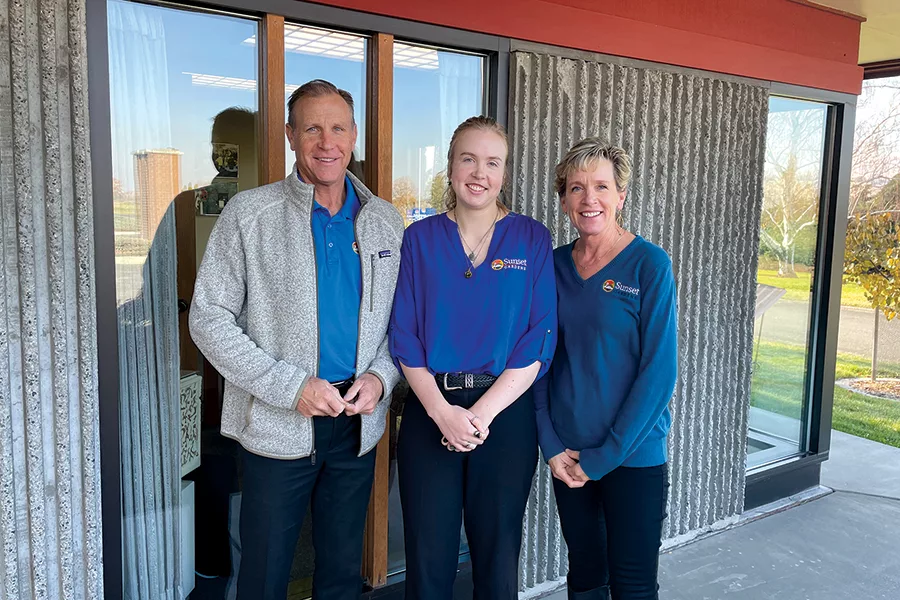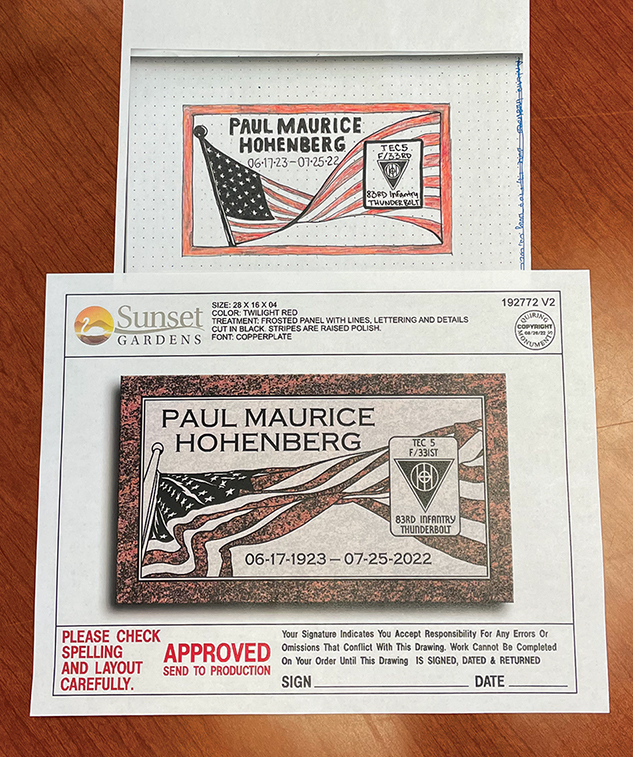
Home » Memorial designer becomes fourth generation to serve grieving families
Memorial designer becomes fourth generation to serve grieving families

December 14, 2022
Sixty-five years after her great-grandfather developed Einan’s Funeral Home, Rory Hollick is now the fourth generation to work there – and you might say she designed her own niche position.
Hollick is Sunset Garden’s first memorial designer, working with families and the engraving company to create custom markers for those who are entombed at the Richland memorial site. “Markers” make up an all-encompassing term for headstones, statues, cremation plaques and more.
She earned a degree in fine arts from Central Washington University after her first job working the grounds at Sunset Gardens, alongside her two siblings. The trio followed in the footsteps of their parents and grandparents who all worked the grounds at one point or another.
“I’ve always been around the cemetery, with my dad, working the grounds crew or every once in a while being brought out to kind of explore,” Hollick said. “So, I’ve always felt comfortable in a cemetery, and it actually surprises me when people get like, ‘Oh, a cemetery?’ It’s not creepy. It’s fine, so that has never been strange to me.”
While at least one person from every Einan’s generation has worked full time at the Richland site since its inception, Hollick might not have expected she would be the one from her generation to fill that role since she gravitated toward art.
“I was always doodling in the margins while growing up,” she said. “It helped me focus while listening to people. Then I started taking my art seriously in high school. That’s when I felt like the actual technical skill came alongside the creative, and I was like, ‘OK, I can do this now.’ ”
Her passions include painting and photography, but her role at Sunset Gardens calls for frequent hand-drawn sketches. She serves as a go between in a couple roles. The counselors who meet with families to plan a funeral and burial now pass the final step to Hollick, who works with the clients to design a marker.
“That’s the last thing they’re going to do in the process, and it takes a little time, and some families find it’s tough making those decisions because once they’re done, they’re done, and it’s going to be there forever. So we want to get it right,” said Pat Hollick, general manager of Sunset Gardens and Rory’s father.
An artist’s eye
In the position since June, Rory has designed more than 60 markers and increased her knowledge of the mediums available, including the variety of types of granite, which is most popular, as well as bronze. She also serves as the liaison between the families and the monument company, which creates a proof to review before a mold is created or an engraving is done.
“There can be limitations on what the company can do, and so they’ll let me know if it’s not going to work because the design is too small for the stone, and I can adapt to that,” Rory said.
Pat also shared that not all types of granite work well in the Tri-Cities’ desert climate, especially when combined with irrigation, and Einan’s want to make sure the display remains as prominent and legible as possible.

Rory finds that much of her responsibility includes art direction, where she takes the vision from the family and puts it to paper. She’ll use her formal training to sketch out a design using her knowledge of the graphics available from the engraver. Seeing a sketch on paper tends to create a better result for all involved.
“I found early on, when you just try to type something out and be like, ‘They want this, this and this,’ and when it would come back, I’d think, ‘That’s not what I meant.’ So, I quickly moved into just drawing it out, so it translates a lot easier and I’ve been getting proofs from (the monument company) a lot faster with that method because it’s already laid out,” Rory said.
Rory has been especially proud of the custom designs she has created for some clients who gave her artistic license to go beyond the pre-designed graphics available for use.
This was the case with the headstone for Paul Hohenberg, the father of Ken Hohenberg, the retired longtime Kennewick police chief and current Port of Kennewick commissioner.
“We wanted something that would really not only memorialize his time in World War II as part of the Greatest Generation, but also honor him as an individual, and it really exceeded expectations. (Rory) should be proud of when she created, I don’t think anyone could have captured it any better,” Ken Hohenberg said.
Einan’s origins
Einan’s Funeral Home began in 1957 with Duaine and Bobbie Einan, Pat’s wife’s grandparents, who volunteered their services to help manage Resthaven Cemetery at 700 Williams Blvd. in Richland. Eventually a community vote formed the Richland Cemetery Association with the purpose of serving the burial and memorial needs of the region.
A volunteer board still governs the organization, and it was the association that bought 70 acres off the Bypass Highway to develop the city’s second cemetery, Sunset Gardens. The funeral home and crematorium were moved to the same location in 1970.
“My wife’s dad and his partners actually sold the funeral home to the association so it’s part of the nonprofit,” Pat said. “The nonprofit can own the funeral home, but it just can’t run the day-to-day operations. It’s now the cemetery’s investment with separate boards and separate managers. The cemetery board has influence over its investment, of course, but they’re separated. I think we’re the area’s largest nonprofit cemetery.”
“By owning the funeral home, it’s protected from being purchased by a conglomerate that doesn’t care about this area, whereas we care about this funeral home,” said Bonnie Hollick, née Einan.
Bonnie is Einan’s office manager in the same way her mother and grandmother were. Bonnie sees her daughter as thriving in this new position that has benefited the whole team.
“Besides having a job format that she’s never done before, I’ve also noticed the families reacting very well to her. They’re very open and very comfortable with her. I don’t know if knowing that she has a background in art makes them even more relaxed.”
It’s a role Rory takes seriously.
“I think growing up with a better understanding of the importance of memorializing those who have passed, and making sure there’s something there, even if it’s something minor, like their name on a wall, is still something you can come and look at. Even if years from now none of the family members are around, someone can still come and say, ‘That person was here.’ I think that’s important,” she said.
Local News
KEYWORDS december 2022





